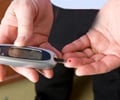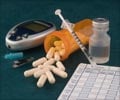The International Diabetes Federation (IDF)’s World Diabetes Day campaign focuses this year on ‘children and adolescents with diabetes’.
Diabetes has a unique impact on the lives of adolescents. According to IDF, children and adolescents with diabetes face a lifetime of living with a disease that poses particular challenges for them. These struggles include higher insulin insensitivity linked to puberty, rapid behavioral changes, increased risk of depression, anxiety, low self-esteem and transition to adult services. These children also require constant monitoring of blood sugar levels, medication and balancing the effects of food and activity.According to IDF, globally there are 500,000 children under age 15 with type 1 diabetes. Of these children, more than a quarter live in South East Asia. Type 2 diabetes is increasing rapidly in children in both developed and developing countries, with some of them as young as eight years of age. Many of them are from ethnic groups known to be at high risk for type 2 diabetes. The majority of children (85%) with type 2 diabetes are overweight or obese at the time of diagnosis.
Type 2 diabetes in young people severely increases the risk developing complications, such as heart disease, prematurely. This can have serious consequences on the child’s health. IDF recommends that provisions be made to deliver the best possible care, prevent long-term complications, and promote further research in order to reach a better understanding of the condition. Type 2 diabetes in children and adolescents, (as also in adults) is due to a combination of insensitivity to insulin and relative failure of beta-cell secretion. There are a number of genetic and environmental risk factors for insensitivity to insulin and limited beta-cell reserves. They include:
• Ethnicity,
• Obesity,
• Sedentary lifestyle,
• Family history of type 2 diabetes,
• Puberty,
• Low birth weight,
• Exposure to diabetes in the uterus,
• Female gender.
There is ample evidence that certain ethnic groups have greater susceptibility to diabetes than others. According to IDF, "there are currently over 250 million people with diabetes; with approximately 120 million of them in the developing world. Increased urbanization, rapid cultural and social changes, unhealthy lifestyles and behavioral patterns mean that 80% of global diabetes cases are predicted to occur in low and middle income countries."
Dr Anoop Misra, Director and Head, Department of Diabetes and Metabolic Diseases, Fortis Hospitals, New Delhi and NOIDA had this to say. Diabetes is part of a larger global epidemic of non-communicable diseases. Because these diseases share many risk factors, therefore policies that encourage healthy eating and active living will prevent not only type 2 diabetes, but also obesity, Cardiovascular Disease (CVD), chronic respiratory illnesses, and diet-related cancers. An integrated system can maximize disease prevention while avoiding the need to develop separate courses of action. Strategies proposed here are prioritized according to their ability to be aligned and integrated into a comprehensive movement that addresses all non-communicable diseases".
"Nutrition plays a very important role in the management of diabetes among adolescents and others. Proper nutritional intake of high fibrous diet with lots of fruits and vegetables, wholesome grain/cereal intake, whole pulses, and a low intake of refined cereals, calorie dense foods, saturated fats, oily / fried / fatty foods needs to be promoted." He further added.
"In growing children and adolescents, allowance must be made for adequate calories and balanced nutrition. Along with proper nutrition, it is very important to encourage daily physical activity" said Dr. Misra.
There is a need to spread the awareness regarding diabetes and the factors that could make adolescents at a high risk for the onset of type 2 diabetes. Those children and adolescents, who have a parent or sibling with type 2 diabetes, should take extra care. They need to strictly maintain normal weight, play or do some aerobic exercises at least 30 minutes a day, take plenty of fruits and vegetables, and avoid junk food.
With careful management by diabetologists, nutritionists, and psychologists, and with support from parents, these young people can lead full and healthy lives. They can participate in sports and compete in other spheres as effectively as those adolescents without diabetes.
"In both urban and rural areas, diabetes in poor children and adolescents does not get diagnosed in time. There could be several reasons for this like lack of education, no proper care, girl child stigma and poverty," said Dr. Sonia Kakkar, a Delhi based doctor. "Though diabetes action has been initiated, efforts are weak and fragmented. Progress is impeded by a health system that places a higher priority on communicable diseases and maternal and child health services and by a private health system driven by curative medicine. However, prevention is cost-effective and should be the main focus", she further added.
A comprehensive approach that addresses type 2 diabetes risk factors is needed. Harnessing positive aspects of globalization - increased information flow, improved technology, and innovation - via international collaboration is crucial. In India, a country with limited health resources, an approach that draws on many sectors - including the private sector - can ensure the successful implementation of the diabetes - care programme for adolescents.
Compiled by: Amit Dwivedi
Edited by: Dr. Reeja Tharu
Source-Medindia













